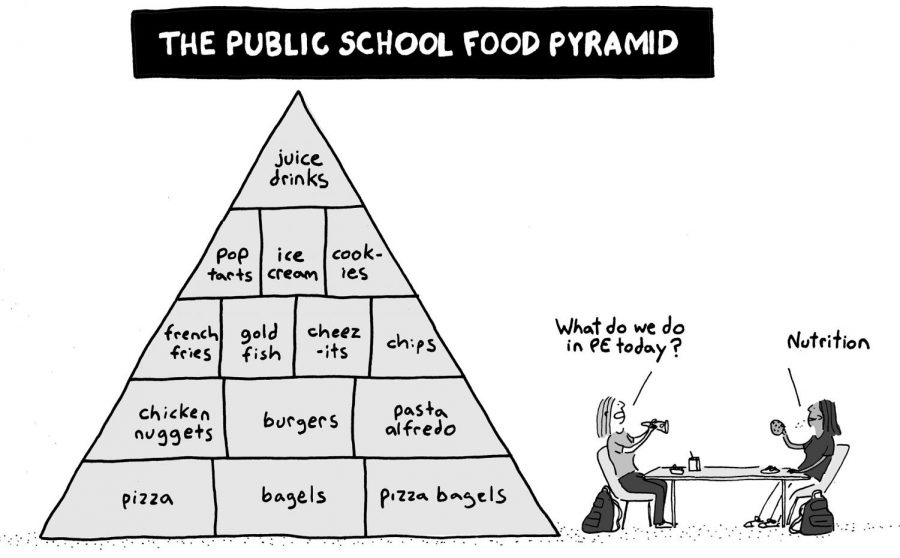Redwood CEA disappoints in health-obsessed county
May 6, 2019
Walk down any street in Marin, and you will likely find references to healthy eating. From organic eateries lining the streets to the newest celebrity–endorsed diet trends on social media, nutrition seems to be at the forefront of everyone’s mind–except at Redwood. Despite the fact that food from the C.E.A. must sustain students until they get home, Redwood’s lunch program mostly offers foods such as chicken nuggets, pizza and hamburgers. It is imperative that the food Redwood sells will actually give students the nutrients they need to get through the rest of the day. But Redwood still does not offer healthy lunch options.
According to Breastcancer.org, healthy eating means, “Eating a variety of foods that give you the nutrients you need to maintain your health, feel good and have energy. These nutrients include protein, carbohydrates, fat, water, vitamins and minerals.”
It should be an easy task to check if Redwood’s lunches fit into this definition of a healthy diet, but nutrition information seems to be kept under lock and key. As of February, all links to nutritional information on the Redwood website were either out of service or contained information from 2012. When I brought this to the attention of the Student Nutrition Services Director, the outdated links were taken down, but it was made clear that it would take a while for the information to be updated.
Despite this setback, one would likely assume that all food served to high schoolers would follow the guidelines of the Recommended Daily Allowances (R.D.A.) and Dietary Guidelines for Americans, as well as guidelines provided by the California Department of Education but, in reality, not all of it does.
The Redwood website states, “To ensure we are meeting these requirements a nutrient analysis is completed for each menu item and the overall week of menu items. Some menu items individually may exceed the requirements so we use a weekly nutrient analysis as the actual guideline since students eat a variety of menu items and the weekly intake is averaged.”
This means that, although as a whole, the weekly Redwood menu meets the nutrition requirements, some individual items do not and because of the outdated website, insight into which items follow the guidelines and which do not is unavailable.
Due to the lack of information on the contents of our school lunches, there is no way to ensure that the food is of acceptable quality, which can have potentially detrimental results. According to the Food Revolution Network, the National School Lunch Program provides lunches to students at over 100,000 schools nationwide, including Redwood. Although the lunches must comply with the nutritional standards from the Dietary Guidelines for Americans, the program provides only $1.30 for schools to spend on each child, leading to cuts in quality. A 2009 U.S.A. Today investigation concluded that the meat the government provides its students with through this program would not meet the standards of many fast food places, including KFC and Jack in the Box.
The benefits of healthy options at lunch outweigh the cost. It has been proven by a study done by the National Bureau of Economic Research in 2017 that healthier school lunches lead to better test scores in schools. In this experiment, researchers analyzed the test scores and school lunch information from all California public schools for five years and found that healthier lunches led to a standardized test score increase of 0.028 standard deviation, which measures how much the test scores vary from the average. While this may not seem like a lot, it adds up across students nationwide.
Teens are in the stage of their lives where they will carry the habits they form now into adulthood, according to a Psychology Today article written by Carl E. Pickhardt, a psychologist and author of 15 parenting books.
“Practiced daily for so many years, [eating habits] are very hard to change in any permanent way through dieting because one’s psychological and physical systems are so historically opposed to giving them up,” Pickhardt said. “People grow very accustomed to what and how much and how often they like to eat.”
If they have the option of healthy alternatives, teens will have the experience of choosing healthier foods which will thus form a habit of healthy eating. On the other hand, teens who are not given that option are less likely to develop that habit, due to their lack of exposure to more nutritious options.
Decision making is a key part of growing up, which is why it is imperative to allow students the opportunity to make their own decisions regarding what they choose to eat. But students cannot make educated choices if they do not know what is in the food they are consuming at school. Though every sophomore student at Redwood is required to take a nutrition unit in PE, they are then served food that does not follow the guidelines they are taught by the very people who taught them these standards. Although it is possible that the food served in the C.E.A. maintains a level of quality and nutrition, the problem is that we really have no idea and no way to find out.
























